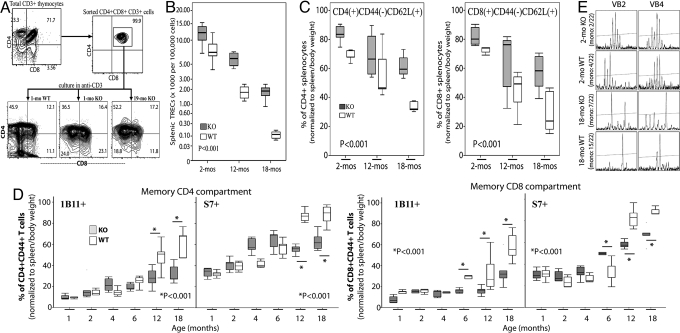Fig. 3.
Old PAPPA−/− mice have robust peripheral T cell repertoire. (A) DP cells of 1-month-old wild-type (WT), and 1-/19-month-old PAPPA−/− (KO) thymi were isolated by cell sorting; incubated in plate-immobilized anti-CD3; and analyzed for CD3, CD4, and CD8 expression after 3 days by flow cytometry. Data shown were representative of 5 mice per age-group examined. (B) Spleens were collected. Splenic TREC levels per 100,000 cells from 5–7 mice per group were measured as in Fig. 1E. (C) Splenocytes were analyzed by flow cytometry for the frequencies of naive CD4 and CD8 T cells defined as CD44−CD62L+ (5–9 mice per group). (D) Cytometric analysis of memory cells defined as CD44+S7+(1B11+) CD4 and CD8 T cells was also done (6–9 mice per group). Asterisk (*) denote significant difference (P < 0.001; Mann–Whitney) between the 2 indicated groups. Box/whisker plots (and P values) in B–D were determined as in Fig. 1B; plots in C and D were normalized to spleen and body weights. (E) T cells were isolated from spleens (3 mice per group) by cell sorting, and subjected to CDR3 spectratyping of 22 TCR BV. Data shown were representative VB2/VB4 spectratypes illustrating Poisson distribution of CDR3 lengths in young mice. Poisson spectratypes, indicating high VB diversity, were infrequent in old mice as shown by limited number of CDR3 signal peaks. Mono, average occurrence of monoclonal, single-peak CDR3 spectratype.

